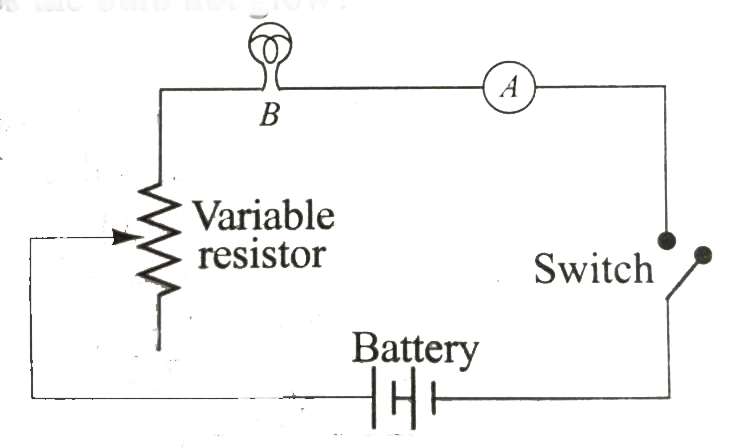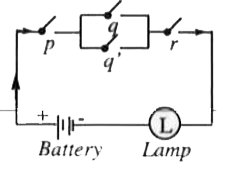In the circuit in Fig. 7.27, bulb B does not glow although ammeter A indicates that the current is flowing . Why does the bulb not glow?

The bulb is fused .
tThere is a break in the circuit between bulb and ammeter.
The variable resistor has too large resistance.
There is a break in the circuit between the bulb and the variable resistance.
The correct Answer is:C
It is a case of weak current.
Topper's Solved these Questions
- HEATING EFFECT OF CURRENTBOOK - CENGAGE PHYSICS ENGLISHCHAPTER - HEATING EFFECT OF CURRENTEXERCISE - Multiple Correct
5 Videos
- HEATING EFFECT OF CURRENTBOOK - CENGAGE PHYSICS ENGLISHCHAPTER - HEATING EFFECT OF CURRENTEXERCISE - Assertion - Reasoning
6 Videos
- HEATING EFFECT OF CURRENTBOOK - CENGAGE PHYSICS ENGLISHCHAPTER - HEATING EFFECT OF CURRENTEXERCISE - Subjective
8 Videos
- GEOMETRICAL OPTICSBOOK - CENGAGE PHYSICS ENGLISHCHAPTER - GEOMETRICAL OPTICSEXERCISE - Integer Type
4 Videos
- INDUCTANCEBOOK - CENGAGE PHYSICS ENGLISHCHAPTER - INDUCTANCEEXERCISE - Concept Based
8 Videos
Similar Questions
When does the current flow through the following circuit ?

View SolutionIn the circuit shown in Fig 7.25,
(a) what must the emfε of the battery be in order for a current of 2.00A to flow through the 5.00V battery , as shown ? Is the polarity of the battery shown is correct?
b. How long does it take for 60.0J of thermal energy to be produced in the 10.0Ωresistor?

View SolutionThe diagram shows a circuit in which a bulb is connected through connecting the wires to a cell.

If the bulb is glowing then what will be the direction of the conventional current in the circuit?
View SolutionA potentiometer circuit is shown in Figure 3. AB is a uniform metallic wire having length of 2 m and resistance of 8Ω. The batteries E1andE2 have emfs of 4V and 1.5 V and their internal resistance are 1Ω and 2Ω respectively.

When the jockey J does not touch the wire AB, calculate :
(a) the current flowing through the potentiometer wire AB.
(b) the potential gradient across the wire AB.
View SolutionThree different elctrolytic cells A, B and C are connected in separate circuits .Electrolytic cell A contains sodium chloride solution. When the circuit is complete . A bulb in the circuit glows brightly .electrolytic cell B contains acetic acid solution and in this case the bulb in the circuit glows dimly . The elctrolytic cell C contains sugar solution and the bulb does not glow . Give a reason for each of these observations .
View SolutionThree different electrolytic cells A, B and C are connected in separate circuits. Electrolytic cell A contains sodium chloride solution. When the circuit is completed, a bulb in the circuit glows brightly. Electrolytic cell B contains acetic acid solution and in this case the bulb in the circuit glows dimly. The electrolytic cell C contains sugаr solution and the bulb does not glow. Give a reason for each of these observations.
View SolutionThe diagram shows a circuit in which a bulb is connected through connecting the wires to a cell.

The bulb in the circuit does not glow. Why?
View SolutionThree incandecent bulbs of 100W each are connected in series in an electric circuit. In another circuit another set of three bulbs of the same wattage are connected in parallel to the same source.
(a) Will the bulbs in the two circuits glow with the same brightness ? Justify your answer.
(b) Now let one bulb in both the circuits get fused. Will the rest of the bulbs continue to glow in each circuit ? Give reason.
View SolutionThe diagram given below (Fig.) shows a bulb connected with a cell having terminals A and B. Mark the direction of current in the bulb.
View SolutionIn the electric circuit shown in Fig. 1, label the parts A, B, C, D, E, and F State the function of each part. Show in the diagram the direction of flow of current.

View Solution
